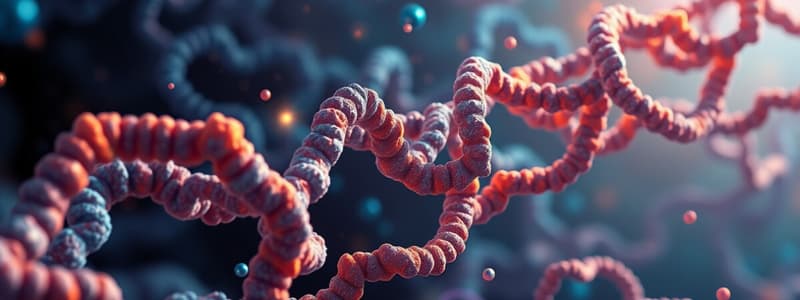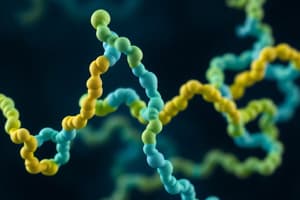Podcast
Questions and Answers
Which statement accurately describes the side chain of glutamine?
Which statement accurately describes the side chain of glutamine?
- It contains a nonpolar aliphatic group.
- It allows for significant protonation at acidic pH.
- It has a carbonyl and a polar amide group. (correct)
- It is purely hydrophilic.
How does the side chain of serine primarily function in enzymatic reactions?
How does the side chain of serine primarily function in enzymatic reactions?
- As a site for phosphorylation and attachment of other groups. (correct)
- As a component of the enzyme’s structure that limits reactivity.
- As a hydrophobic anchor.
- By forming ionic bonds with negatively charged substrates.
What characteristic of tyrosine makes it more likely to engage in hydrogen bonding?
What characteristic of tyrosine makes it more likely to engage in hydrogen bonding?
- Its lack of a substituent on the ring.
- Its purely nonpolar structure.
- Its significant hydrophobic nature.
- The presence of a hydroxyl group on its phenyl ring. (correct)
In what significant way does threonine's side chain differ from serine's?
In what significant way does threonine's side chain differ from serine's?
Which aspect of glutamine's structure contributes to its nonpolar character?
Which aspect of glutamine's structure contributes to its nonpolar character?
Which of the following amino acids has a side chain that can lose a proton at alkaline pH?
Which of the following amino acids has a side chain that can lose a proton at alkaline pH?
What impact does the polar hydroxyl group have on serine and threonine?
What impact does the polar hydroxyl group have on serine and threonine?
What role do the side chains of tyrosine and serine have in enzyme function?
What role do the side chains of tyrosine and serine have in enzyme function?
Which lipid group is often attached to plasma membrane proteins?
Which lipid group is often attached to plasma membrane proteins?
What is the main characteristic of the α-carbon in amino acids?
What is the main characteristic of the α-carbon in amino acids?
Which statement correctly describes farnesyl and geranyl groups?
Which statement correctly describes farnesyl and geranyl groups?
What role do lipid groups play in membrane proteins?
What role do lipid groups play in membrane proteins?
Which of these options correctly identifies a feature of the myristoyl group?
Which of these options correctly identifies a feature of the myristoyl group?
Which of the following statements is true about palmitoyl and myristoyl groups?
Which of the following statements is true about palmitoyl and myristoyl groups?
What is a common feature of farnesyl and geranyl groups in membrane proteins?
What is a common feature of farnesyl and geranyl groups in membrane proteins?
How do regulatory modifications impact proteins?
How do regulatory modifications impact proteins?
What happens to lysine at physiologic pH?
What happens to lysine at physiologic pH?
Which structural feature distinguishes lysine and arginine?
Which structural feature distinguishes lysine and arginine?
How does the side chain of lysine participate in binding interactions?
How does the side chain of lysine participate in binding interactions?
What is a key characteristic of arginine's side chain when compared to lysine's?
What is a key characteristic of arginine's side chain when compared to lysine's?
Which property is associated with the side chains of both lysine and arginine?
Which property is associated with the side chains of both lysine and arginine?
In terms of charge and interaction characteristics, how do lysine and arginine behave in physiological conditions?
In terms of charge and interaction characteristics, how do lysine and arginine behave in physiological conditions?
Which of the following describes a function of the guanidinium group in arginine?
Which of the following describes a function of the guanidinium group in arginine?
What type of binding can lysine participate in due to its side chain properties?
What type of binding can lysine participate in due to its side chain properties?
What role do calcium ions play in the carboxylation of the γ carbon of glutamate?
What role do calcium ions play in the carboxylation of the γ carbon of glutamate?
What happens to the carboxyl group (-COOH) of glutamate when the pH is elevated?
What happens to the carboxyl group (-COOH) of glutamate when the pH is elevated?
What is a key feature of hydroxyproline in collagen?
What is a key feature of hydroxyproline in collagen?
Which characteristic defines molecules that assume a dipolar form (zwitterion)?
Which characteristic defines molecules that assume a dipolar form (zwitterion)?
Which proteins are specifically mentioned in association with the dissociation of the carboxyl group?
Which proteins are specifically mentioned in association with the dissociation of the carboxyl group?
What is primarily responsible for the dipolar nature of molecules like glutamate at physiological pH?
What is primarily responsible for the dipolar nature of molecules like glutamate at physiological pH?
Hydroxylation of which amino acid is crucial for the structural integrity of collagen?
Hydroxylation of which amino acid is crucial for the structural integrity of collagen?
Which of the following is most accurate regarding the significance of the γ carbon carboxylation process?
Which of the following is most accurate regarding the significance of the γ carbon carboxylation process?
What occurs when the pH is less than the pKa of carboxylic acid groups?
What occurs when the pH is less than the pKa of carboxylic acid groups?
At which pH does the form II and III of alanine exist in equal amounts?
At which pH does the form II and III of alanine exist in equal amounts?
What characterizes alanine at its isoelectric point?
What characterizes alanine at its isoelectric point?
Which buffers are associated with the pK1 and pK2 regions of alanine?
Which buffers are associated with the pK1 and pK2 regions of alanine?
What is true about amino acids at physiologic (nearly neutral) pH?
What is true about amino acids at physiologic (nearly neutral) pH?
Which form of alanine is predominantly present at neutral pH?
Which form of alanine is predominantly present at neutral pH?
What defines an amphoteric substance in the context of amino acids?
What defines an amphoteric substance in the context of amino acids?
What is the net charge of amino acids at physiologic pH?
What is the net charge of amino acids at physiologic pH?
Flashcards are hidden until you start studying
Study Notes
Glutamine and Related Amino Acids
- Glutamine (Gln, Q) features a side chain with a carbonyl and polar amide group, contributing to its hydrophilic nature.
- The side chain of glutamine possesses no substituents and can stack hydrophobically.
- Serine (Ser, S) has a polar hydroxyl group on its side chain that serves as an attachment site for groups like phosphates, critical for enzyme active sites.
- Tyrosine has a hydroxyl group on the phenyl ring, increasing its polarity and hydrophilicity; can participate in hydrogen bonds and attachment of phosphate groups.
- Threonine (Thr, T) also contains a polar hydroxyl group for attachment, notably oligosaccharides in glycoproteins.
- Lysine (Lys, K) features a positively charged side chain with a primary amino group that forms ionic bonds at physiological pH.
- Arginine (Arg, R) has similar characteristics to lysine, characterized by its guanidinium group.
Properties of Acidic and Basic Amino Acids
- Acidic and basic amino acids facilitate hydrogen bonding and salt bridge formation.
- Salt bridges involve ionic interactions between negatively charged groups and positively charged ions, e.g., sodium.
Fatty Acylation and Prenylation
- Membrane proteins can have covalently attached lipid groups that interact hydrophobically within the membrane.
- Palmitoyl (C16) groups frequently attach to plasma membrane proteins.
- Myristoyl (C14) groups are commonly found in lipid membranes of intracellular vesicles.
- Farnesyl (C15) or Geranyl (C20) groups, synthesized from isoprene units, attach to specific cysteine residues in membrane proteins.
Optical Properties of Amino Acids
- All amino acids except glycine possess a chiral α-carbon that is optically active, attached to four different groups.
- Glycine is optically inactive due to having two identical substituents on its α-carbon.
Regulatory Modifications of Amino Acids
- Carboxylation of the γ-carbon of glutamate plays a role in blood clotting by assisting calcium ion attachment.
- Hydroxylation, as seen in collagen, adds OH groups to proline, enhancing hydrogen bonding between polypeptide chains.
Isoelectric Points and pH Effects
- Amino acids exist primarily in protonated form at low pH, transitioning to carboxylate forms as pH increases.
- At pH equating to pKa, different ionic forms of amino acids are equally represented.
- The isoelectric point of alanine occurs at neutral pH, where it predominantly exists as a zwitterion with no net charge.
- Amino acids are amphoteric, serving as ampholytes capable of acting as acids or bases depending on environmental pH.
Net Charge of Amino Acids
- At physiological pH, amino acids exist as zwitterions, featuring both carboxylate (-COO-) and ammonium (-NH3+) functional groups, resulting in a neutral net charge.
Studying That Suits You
Use AI to generate personalized quizzes and flashcards to suit your learning preferences.




